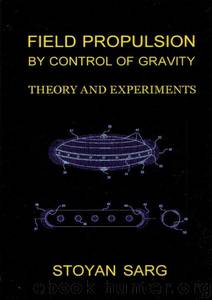Field Propulsion by Control of Gravity by Stoyan Sarg

Author:Stoyan Sarg [Sarg, Stoyan]
Language: eng
Format: epub
Tags: Science / Alternative
Published: 2012-01-27T23:09:41+00:00
-Dynamic CL pressure, P - (related to the Zero Point
D
Energy of Dynamic type and responsible for the electrical and magnetic fields and the quantum behavior of the elementary particles):
P = hv /(cS ) = 2025.8 ( N/(m2Hz)) (3)
D
c
e
where: h - Planck constant, v - Compton frequency, S - impenetrable
c
e
surface of the electron structure (cut torus)
- Partial CL pressure, P - related to the confined motion
P
of the electron with one of its quantum velocities, .in which the signature of the fundamental Fine Structure Constant α plays a role. The confine motion influences the motion of the atoms, molecules and solids as discussed in Chapter 10 of BSM-SG (from §10.4.1 to §10.4.6). From that analysis it was found that for electron velocity of u = ac the ratio between the Partial and Dynamic CL pressure is a function solely of the fine structure constant.
P / P = α 2 ( l - α 2 ) - 1 / 2
(4)
P
S
Consequently, the fine structure constant plays important role for the quantum mechanical interactions between the electrons in confined motion and the physical vacuum. At the same time the fine structure constant is embedded in the structure of the electron (Chapter 3
of BSM-SG) and its signature is persistent in the quantum electron orbits (see §7.5 - §7.8 of BSM-SG, Chapter 7).
The Dynamic CL pressure is related to the Zero Point Energy
envisioned by Quantum Mechanics. The Static CL pressure is related to a hidden Zero Point Energy, envisioned by the BSM-SG theory. For this pressure the Einstein Equation E = mc is valid.
Using the Static CL pressure, the mass equation (5) of a stable elementary particle is derived (BSM-SG, Chapter 3).
4 h v 4(1-α2)
c
m = ———————
(5)
πα2c5
where: V - is the impenetrable volume of the elementary
E P
particle, h - is the Planck constant
The Complex CL node dynamics is characterized by two identifiable cycles - one with a proper resonance frequency
v = 1.093 x 1029 Hz (defining light velocity as one cycle per one
R
CL node distance) and the Compton time with a frequency
v = 1.236 x 102° Hz, defining the permittivity and permeability
c
of the physical vacuum (BSM-SG, Chapter 2). The Compton cycle involves a number of whole resonance cycles.
Since the neighboring nodes are interconnected by SG forces, the following unveiled features of the CL node are quite important for understanding the properties of the physical vacuum:
•SG forces are based on frequency higher than the proper resonance frequency of the CL node, while their propagation through CL
structure as Newtonian gravity depends on the mutual phases of the oscillating CL nodes.
•The mutual interaction between the oscillating CL nodes causes a self-synchronization effect at the Compton frequency that is a second proper frequency of the CL node ( defined by a full spatial cycle of the SPM vector)
•The effect of self-synchronization appears as permanently existing and recombining Zeropoint waves. They are responsible for the constant value of s and u defining the constant light velocity
0
0
according to the formulae
c = (ε μ )-0.5
(6)
0 0
In Chapter 10 of BSM-SG, it was shown that
Download
This site does not store any files on its server. We only index and link to content provided by other sites. Please contact the content providers to delete copyright contents if any and email us, we'll remove relevant links or contents immediately.
The Complete Stick Figure Physics Tutorials by Allen Sarah(7135)
Secrets of Antigravity Propulsion: Tesla, UFOs, and Classified Aerospace Technology by Ph.D. Paul A. Laviolette(4974)
Thing Explainer by Randall Munroe(3782)
The River of Consciousness by Oliver Sacks(3412)
The Order of Time by Carlo Rovelli(3071)
How To by Randall Munroe(2911)
I Live in the Future & Here's How It Works by Nick Bilton(2839)
A Brief History of Time by Stephen Hawking(2819)
What If?: Serious Scientific Answers to Absurd Hypothetical Questions by Randall Munroe(2542)
The Great Unknown by Marcus du Sautoy(2532)
Midnight in Chernobyl by Adam Higginbotham(2384)
Blockchain: Ultimate Step By Step Guide To Understanding Blockchain Technology, Bitcoin Creation, and the future of Money (Novice to Expert) by Keizer Söze(2379)
Networks: An Introduction by Newman Mark(2264)
The Meaning of it All by Richard Feynman(2213)
Easy Electronics by Charles Platt(2204)
The Tao of Physics by Fritjof Capra(2162)
Midnight in Chernobyl: The Untold Story of the World's Greatest Nuclear Disaster by Adam Higginbotham(2074)
When by Daniel H Pink(2019)
Introducing Relativity by Bruce Bassett(2015)
